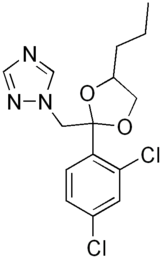Propiconazole
- Propiconazole
-
| Propiconazole |
 |
| Général |
| Nom IUPAC |
(+)-1-[2-(2,4-dichlorophényl)-4-propyl-1,3-dioxolan-2-ylméthyl]-1H-1,2,4-triazole |
| No CAS |
60207-90-1 |
| No EINECS |
262-104-4 |
| SMILES |
CC1= C( C= CC= C1C2= CC= CC= C2) COC([ C@@ H] 3[ C@ H]( C= C( C( F)( F) F) Cl) C3( C) C)= O
PubChem, Vue 3D
|
| InChI |
InChI : Vue 3D
InChI= 1/ C23H22ClF3O2/ c1- 14- 16( 10- 7- 11- 17( 14) 15- 8- 5- 4- 6- 9- 15) 13- 29- 21( 28) 20- 18( 22( 20, 2) 3) 12- 19( 24) 23( 25, 26) 27/ h4- 12, 18, 20H, 13H2, 1- 3H3/ b19- 12-/ t18-, 20-/ s3
|
| Apparence |
liquide jaune clair à jaune foncé |
| Propriétés chimiques |
| Formule brute |
C15H17Cl2N3O2 [Isomères]
|
| Masse molaire[1] |
342,22 ± 0,018 g·mol-1
C 52,64 %, H 5,01 %, Cl 20,72 %, N 12,28 %, O 9,35 %,
|
| pKa |
1,09 |
| Propriétés physiques |
| T° fusion |
-23 °C |
| T° ébullition |
180 °C à 0,1 mmHg |
| Solubilité |
100 ppm à 20 °C.
110 mg/L dans l'eau à 20 °C |
| Masse volumique |
1,29 g·cm-3 à 20 °C |
| T° d'auto-inflammation |
430 °C |
| Point d’éclair |
> 150 °C |
| Pression de vapeur saturante |
Négligeable |
| Précautions |
|
Directive 67/548/EEC
|

Xn
|

N
|
|
Numéro index :
613-205-00-0
Symboles :
Xn : Nocif
N : Dangereux pour l’environnement
Phrases R :
R22 : Nocif en cas d’ ingestion.
R43 : Peut entraîner une sensibilisation par contact avec la peau.
R50/53 : Très toxique pour les organismes aquatiques, peut entraîner des effets néfastes à long terme pour l’ environnement aquatique.
Phrases S :
(S2) : Conserver hors de portée des enfants.
S46 : En cas d’ ingestion, consulter immédiatement un médecin et lui montrer l’ emballage ou l’ étiquette.
S60 : Éliminer le produit et son récipient comme un déchet dangereux.
S61 : Éviter le rejet dans l’ environnement. Consulter les instructions spéciales/ la fiche de données de sécurité.
S36/37 : Porter un vêtement de protection et des gants appropriés.
|
| Phrases R : 22, 43, 50/53, |
| Phrases S : (2), 36/37, 46, 60, 61, |
|
SGH[2]
|
 
Attention
H302, H317, H410,
H302 : Nocif en cas d'ingestion
H317 : Peut provoquer une allergie cutanée
H410 : Très toxique pour les organismes aquatiques, entraîne des effets à long terme
|
| Écotoxicologie |
| DL50 |
1 517 mg·kg-1 rat oral
4 000 mg·kg-1 rat peau |
| CL50 |
1264 mg/m³/4 heures rat inhalation |
|
Unités du SI & CNTP, sauf indication contraire.
|
Le propiconazole est un fongicide utilisé en agriculture.
Il a été mis au point en 1979 par Janssen Pharmaceutica.
Voir aussi
Articles connexes
Références
Wikimedia Foundation.
2010.
Contenu soumis à la licence CC-BY-SA. Source : Article Propiconazole de Wikipédia en français (auteurs)
Regardez d'autres dictionnaires:
Propiconazole — Chembox new Reference= [ Merck Index , 11th Edition, 7830.] ImageFile=Propiconazole.png ImageSize=180px IUPACName=1 [ [2 (2,4 dichlorophenyl) 4 propyl 1,3 dioxolan 2 yl] methyl] 1,2,4 triazole OtherNames= Section1= Chembox Identifiers CASNo=60207 … Wikipedia
propiconazole — noun The herbicide (2RS,4RS;2RS,4SR) 1 [2 (2,4 dichlorophenyl) 4 propyl 1,3 dioxolan 2 ylmethyl] 1H 1,2,4 triazole … Wiktionary
60207-90-1 — Propiconazole Propiconazole Général Nom IUPAC (+) 1 [2 (2,4 dichlorophényl) 4 propyl 1,3 dioxolan 2 ylméthyl] 1H 1,2,4 triazole … Wikipédia en Français
C15H17Cl2N3O2 — Propiconazole Propiconazole Général Nom IUPAC (+) 1 [2 (2,4 dichlorophényl) 4 propyl 1,3 dioxolan 2 ylméthyl] 1H 1,2,4 triazole … Wikipédia en Français
Taura syndrome — Taxobox virus group = iv familia = Discistroviridae species = Taura syndrome virus The controversyTaura syndrome (TS) was first described in Ecuador during the summer of 1992. In March 1993, it returned as a major epidemic and was the object of… … Wikipedia
Arsenic — (pronEng|ˈɑrsənɪk) is a chemical element that has the symbol As and atomic number of 33. Arsenic was first documented by Albertus Magnus in 1250cite book |last=Emsley |first=John |title=Nature s Building Blocks: An A Z Guide to the Elements |year … Wikipedia
Dutch elm disease — Branch death, or flagging, at multiple locations in the crown of a diseased elm Dutch elm disease (DED) is a disease caused by a member of the sac fungi category, affecting elm trees which is spread by the elm bark beetle. Although believed to be … Wikipedia
Wood preservation — All measures that are taken to ensure a long life of wood fall under the definition wood preservation (timber treatment). Apart from structural wood preservation measures, there are a number of different (chemical) preservatives and processes… … Wikipedia
Powdery mildew — is a fungal disease that affects a wide range of plants. Powdery mildew diseases are caused by many different species of fungi in the order Erysiphales. It is one of the easier diseases to spot, as its symptoms are quite distinctive. Infected… … Wikipedia
List of fungicides — This page aims to list well known chemical compounds, to stimulate the creation of Wikipedia articles.This list is not necessarily complete or up to date ndash; if you see an article that should be here but isn t (or one that shouldn t be here… … Wikipedia





